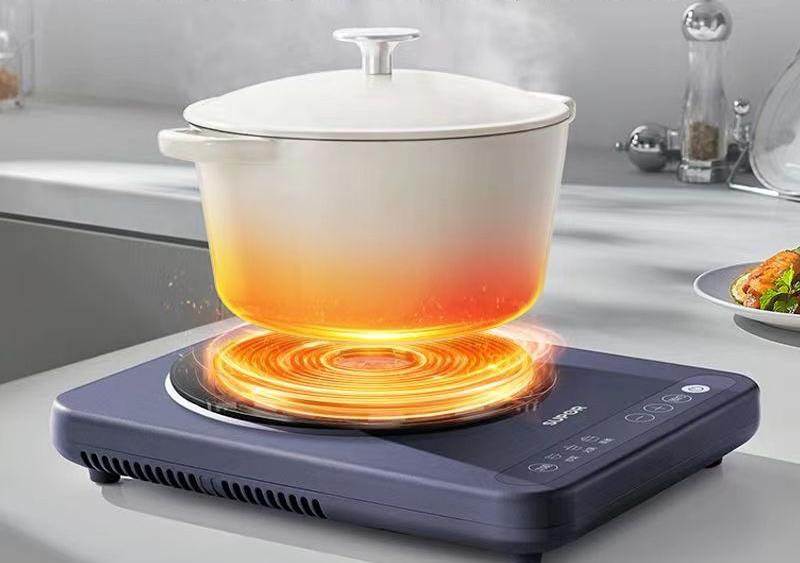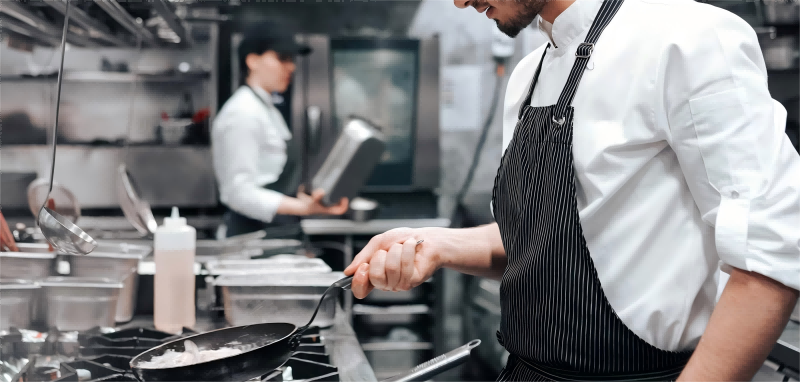퓨어쿡 주방용품 제조r에서는 인덕션 조리 기술의 부상과 맞춤형 스테인리스 스틸 조리기구가 현대 요리 경험을 어떻게 향상시킬 수 있는지 자세히 살펴봅니다.
소개
기술과 소비자 행동이 주도하는 요리 공간에 거대한 변화가 일어나고 있습니다. 이러한 변화를 주도하는 인덕션 스토브는 요리에 있어 최고의 효율성, 정밀성, 안전성을 제공하는 가전제품입니다. 가정주부와 전문 셰프 모두 인덕션 요리를 도입하여 주방을 꾸미고자 하면서, 특히 조리기구를 구매할 때 이 기술과의 호환성이 주요 구매 요인이 되었습니다. 요리에 필요한 맞춤형 조리기구를 찾는다면 내구성과 세계 최고 수준의 매력으로 인해 스테인리스 스틸 조리기구가 최고의 선택 중 하나입니다.
이 글에서는 인덕션 스토브가 점점 더 인기를 얻고 있는 이유, 인덕션 호브에 스테인리스 스틸 조리기구를 사용하는 것과 관련된 문제, 맞춤형 인덕션 조리기구를 구입하는 것이 더 나은지 아니면 호브를 구입하는 것이 더 나은지에 대해 논의합니다. 이번 분석은 독자들이 다음에 주방 가전이나 조리기구를 교체할 때 올바른 결정을 내리는 데 필요한 정보를 제공하기 위한 것입니다.
인덕션 스토브의 부상
조리 기기의 기술 발전입니다.
인덕션 쿡탑은 요리 기술의 비약적인 발전입니다. 인덕션 스토브는 기존의 가스나 전기 스토브처럼 불꽃이나 발열체에서 조리기구로 열이 전도되는 방식이 아니라 조리기구 자체에서 직접 열을 발생시킵니다. 이러한 열 발생 방식은 여러 가지 이점을 제공합니다:
효율성: 인덕션 스토브의 에너지 전달 효율은 약 84%인 반면 가스는 약 40%, 기존 전기 레인지의 경우 약 74%의 에너지를 전달합니다. 따라서 에너지 소비량이 훨씬 적고 공과금 부담도 훨씬 덜합니다.
빠른 가열: 에너지 전달이 직접 이루어지므로 조리기구가 더 빨리 가열됩니다. 음식이 더 빨리 익고 물이 더 빨리 끓기 때문에 식사 시간이 단축됩니다.
정밀한 온도 제어: 인덕션 스토브는 즉각적이고 정밀한 온도 변화를 제공하므로 요리사가 조리 과정을 더 잘 제어할 수 있습니다.
안전 기능 - 쿡탑 자체가 매우 뜨거워지지 않기 때문에 화상 가능성이 매우 낮습니다. 또한 인덕션 스토브에는 일반적으로 냄비가 없을 때 스토브가 꺼지는 자동 차단 기능이 있습니다.

시장 트렌드 및 소비자 선호도
인덕션 쿡탑 역시 주방 가전 시장의 전반적인 발전과 함께 전 세계적으로 강력한 성장세를 보이고 있습니다. Grand View Research(2021)에서 발췌한 보고서에 따르면 이 시장은 2021년부터 2028년까지 8.1%의 CAGR로 2028년까지 273억 달러에 달할 것으로 예상됩니다. 여기에는 여러 가지 이유가 있습니다.
- 환경 문제: 소비자들의 인식이 점점 더 높아지면서 에너지 사용량과 CO2 배출량을 줄여 환경에 도움이 되는 가전제품을 구매하고자 합니다.
- 현대적인 외관: 요즘 인덕션 스토브는 매우 깔끔하고 미니멀한 디자인으로 주방 장식 스타일과 잘 어울립니다.
- 도시화와 적은 공간: 최소 공간 인덕션 쿡탑은 주방 면적이 적은 도시형 라이프스타일의 가정에 적합합니다.
- 건강 및 안전 개선: 화염이 없으므로 실내 공기 오염과 화재 위험이 적습니다.

전문 주방에서 채택
그러나 인덕션 기술은 요리 전문가와 상업용 주방에서도 채택되고 있습니다. 인덕션 조리는 조리 품질과 속도를 향상시키고, 주방 환경을 시원하게 유지하여 작업 환경이 더 시원해집니다. 이제 유수의 요리 학교에서는 교육에 인덕션 스토브를 점점 더 많이 사용하고 있으며, 이는 새로운 업계 표준을 제시하고 있습니다.
스테인리스 스틸: 사용 시기 및 이점
스테인리스 스틸 조리기구가 인기 있는 이유는?
조리기구는 스테인리스 스틸로 만든 주방용품 중 가장 선호도가 높은 유형입니다:
- 견고함: 스테인리스 스틸 조리기구는 녹, 부식, 얼룩이 잘 생기지 않아 오래 사용할 수 있는 옵션입니다.
- 반응하지 않음: 산성 또는 알칼리성 음식과 중성을 유지하며 일반 레시피에서도 풍미를 유지할 수 있습니다.
- 손쉬운 관리: 스테인리스 스틸 표면은 대부분 식기세척기 사용이 가능하므로 쉽게 세척하고 관리할 수 있습니다.
- 미적 속성: 스테인리스 스틸의 깨끗하고 반짝이는 특성은 주방에 전문적인 느낌을 줍니다.
인덕션 호환성에 대한 더 깊은 느낌 얻기
모든 냄비와 프라이팬을 인덕션 쿡탑에서 사용할 수 있는 것은 아니며, 자성이 있는 조리도구만 사용할 수 있습니다. 인덕션 쿡탑은 전자기장을 생성하여 조리기구에 전류를 흘려보내고 열을 발생시킵니다. 따라서 조리기구는 강자성 소재(철 또는 자성 스테인리스 스틸)로 만들어져야 합니다.
스테인리스 스틸의 종류
스테인리스 스틸에는 다양한 등급과 구성이 있습니다:
- 오스테나이트 스테인리스 스틸(300 시리즈): 크롬과 니켈 함량이 높아 내식성이 높고 자성을 띠지 않습니다.
- 페라이트계 SS(400 시리즈): 크롬 함량은 높지만 니켈 함량은 매우 낮으므로 강자성 및 인덕션이 가능합니다.
이제 모든 스테인리스 스틸 조리기구가 인덕션 친화적인 것은 아닙니다. 제조업체는 조리기구 바닥에 자기층을 내장하여 이 문제를 해결했습니다.
인덕션 사용을 위한 조리기구 테스트
인덕션 스토브에 사용하기에 가장 적합한 스테인리스 스틸 조리기구는 다음과 같습니다:
- 자성 잔류: 조리기구에 '인덕션 사용 가능' 또는 '인덕션 호환' 라벨이 붙어 있는지, 즉 자성층이 있는지 확인하세요.
- 내구성 있는 구조: 다중 레이어 또는 클래드 구조; 레이어드 금속은 열 분산과 성능 향상에 도움이 될 수 있습니다.
- 평평한 바닥면: 인덕션 쿡탑과 완전히 밀착되어 에너지 전달이 극대화됩니다.
제작 조리기구가 도착했습니다.
맞춤형 요리 요구 사항
요리사마다 요리 스타일, 레시피, 주방 세팅에 따라 각자의 취향과 요구 사항이 다릅니다. 맞춤형 조리 도구는 개인별 맞춤화를 통해 개인의 고유한 요구 사항을 해결합니다:
- 소재 디자인: 특정 등급의 스테인리스 스틸 또는 금속 혼합물을 사용하여 원하는 열적 특성을 얻습니다.
- 디자인 사양: 크기, 모양 및 손잡이와 뚜껑의 모양을 수정하여 더 사용자 친화적으로 만들 수 있습니다.
- 실용적인 추가 기능: 계량 표시, 따르는 스파우트 또는 인체공학적으로 설계된 손잡이 등.
인덕션 스토브에서 맞춤형 조리기구의 장점
맞춤 조리기구를 구매하면 다음과 같은 몇 가지 장점이 있습니다:
- 기능 보장: 맞춤형 조리기구는 인덕션과 호환되도록 특별히 설계할 수 있으므로 자기 특성에 대해 걱정할 필요가 없습니다.
- 성능: 조리기구의 두께와 디자인이 열 분배와 보존에 최적화되어 있어 조리 성능이 향상됩니다.
- 주방 주변 장식과 어울리도록 하세요: 맞춤형 디자인은 주방 장식과 요리사의 페르소나를 항상 일치시켜 더욱 매끄럽게 조화를 이룰 수 있습니다.
- 내구성 및 지속 가능성: 고품질 소재 공정을 통해 교체 횟수를 줄이면서 내구성을 보장합니다.
예시: 맞춤형 조리기구 솔루션
전문 셰프
일상적인 요리사라면 매일 혹독한 사용에도 견딜 수 있고 정확성을 제공하는 조리 도구의 이점을 누릴 수 있습니다. 맞춤형 금속 조리기구는 이 모든 것을 견딜 수 있도록 구조적 보강과 특정 금속 성분으로 설계할 수 있습니다.

가정 요리 애호가
예를 들어, 특정 요리를 좋아하는 가정 요리사에게는 인덕션 스토브로 담금질할 수 있는 평평한 바닥의 냄비 등 특별한 장비가 필요할 수 있습니다. 맞춤형 디자인은 전통을 현대 기술로 구현하는 것입니다.
인덕션 조리 및 인덕션 팬 재료에 대한 철저한 검사.
조리기구 성능 및 열전도율
인덕션 스토브에서 조리기구의 성능은 열전도율, 즉 열이 물질을 얼마나 빨리 통과하는지에 따라 결정됩니다. 열전도율이 높은 비자성 금속에는 구리와 알루미늄이 있습니다. 구리는 열전도율은 낮지만 스테인리스 스틸의 내구성과 자성 측면에 적합합니다.
멀티 플라이 구조
멀티플 구조를 통해 제조업체는 이러한 속성의 균형을 맞춥니다:
- 3중 조리기구: 스테인리스 스틸의 다른 두 층 사이에 알루미늄 또는 구리 층이 끼워져 있습니다. 알루미늄/구리 열전도율과 인덕션 호환성 및 내구성이 뛰어난 스테인리스 스틸을 결합한 디자인입니다.
- 충격 결합 베이스: 스테인리스 스틸 조리기구의 바닥에 알루미늄 또는 구리 디스크가 접착되어 있어 인덕션 호환성에 영향을 주지 않고 열을 분산할 수 있습니다.
인덕션 성능 및 조리기구 구조.

인덕션 조리 효율은 다음에 의해 영향을 받습니다:
- 조리기구의 크기와 모양: 효율적으로 작동하려면 조리기구가 인덕션 버너의 크기에 맞아야 합니다.
- 소재의 두께 : 두꺼운 소재는 열을 더 고르게 발산할 수 있지만 온도 변화가 느려질 수 있습니다!
- 평평한 표면: 평평한 바닥은 음식을 효율적으로 조리하기 위한 에너지 전달에 중요한 쿡탑과 안정적으로 접촉할 수 있게 해줍니다.
안전 및 규정 준수
맞춤형 조리기구는 안전 및 규제 표준을 준수해야 합니다:
- 식품 안전 규정 - 사용되는 재료는 식품 접촉에 안전해야 하며 납이나 카드뮴과 같은 유해 물질을 포함하지 않아야 합니다.
- 제조 기준: 조리기구를 제조하는 품질 관리 표준은 조리기구의 성능을 보장합니다.
- 인덕션 쿡탑용: 제조업체는 인덕션 쿡탑에서 사용하기 위해 제품을 테스트하고 인증해야 하므로 소비자는 안심하고 사용할 수 있습니다.
소비자를 위한 실용적인 고려 사항.
요리 습관 평가
인덕션 스토브와 함께 사용할 수 있는 조리기구로 전환하기 전에 소비자가 고려해야 할 사항이 있습니다:
- 얼마나 자주 요리를 하나요? 인덕션 요리의 장점이 일상적인 요리 습관과 양립할 수 있는지 평가하세요.
요리 방법: 일부 조리 방법은 조리 온도를 정밀하게 제어해야 하므로 인덕션으로 더 잘 조리되는 경향이 있습니다.
- 인덕션 인벤토리: 이미 보유하고 있는 인덕션 조리가 가능한 제품과 맞춤형 조리 도구가 도움이 될 수 있는 제품을 평가하세요.
예산 및 투자
인덕션 쿡탑과 이와 관련된 맞춤형 조리기구는 처음부터 더 비싸다는 점도 염두에 두세요:
- 장기적으로 비용을 절약하세요: 집의 에너지 효율을 높이면 공과금을 크게 절약할 수 있습니다.
- 수명: 좋은 조리기구는 오래 사용할 수 있어 교체 비용이 절감됩니다.
- 향상된 요리 경험: 열성적인 요리사라면 한계 성능을 위해 비용을 지불할 가치가 있을 수 있습니다.
환경 영향
인덕션 요리도 환경 친화적 인 요리이며 그 이유는 다음과 같습니다:
- 에너지 소비 감소: 품질은 효율로 이어지고, 효율은 요리에 필요한 에너지 소비 감소로 이어집니다.
- 배출가스 감소 : 전기 인덕션 스토브는 가스레인지의 연소 가스를 제거합니다.
- 친환경 소재: 맞춤형 주방용품은 재활용 가능한 재료로 제작하여 지구 자원 낭비를 더욱 줄일 수 있습니다.
조리 기술과 조리기구의 미래는 어떻게 될까요?
더 나은 인덕션 기술을 향해
유도 기술연구, 개선 및 응용 분야에서 계속 성장하고 있습니다.
스마트 쿡탑: 첨단 기술이 적용된 이 쿡탑을 사용하면 IoT 기기와 연동하여 소파에서 편안하게 요리 과정을 모니터링하고 제어할 수 있습니다.
- 유연한 화구: 최신 디자인으로 크고 특이한 모양의 조리기구도 쉽게 사용할 수 있어 명절에 매우 유용합니다.
- 개선된 사용자 인터페이스: 터치스크린 컨트롤과 프로그래밍 가능한 설정으로 더 나은 사용자 경험을 제공합니다.
지속 가능한 원자재 조달 및 생산.
조리기구 업계가 주목하고 있는 부분입니다:
지속 가능한 합금 및 코팅: 성능 저하 없이 독성 물질을 친환경 대체재로 대체하는 지속 가능한 합금 및 코팅 개발의 발전
- 책임감 있는 제조 친환경 제조 관행: 폐기물을 줄이고 에너지 효율적인 프로세스를 사용하여 제품을 생산합니다.
커스터마이징 및 개인화 트렌드
제품의 개인화 개인화된 제품에 대한 소비자의 수요가 증가하고 있습니다:
- 소비자는 온라인 도구를 사용하여 조리기구의 기능과 외관을 개인화할 수 있습니다.
- 디자이너와 셰프의 콜라보레이션: 파트너십을 통해 식품 전문가의 탁월한 디자인과 관점을 제공합니다.
결론
이는 주방 통합의 긍정적인 진전으로, 그 어느 때보다 효율성, 안전성, 정밀성이 요구되는 시대에 주방의 세 가지 요소를 모두 충족할 수 있게 해줍니다. 이 기술은 특히 적응성을 제공하거나 요리 경험을 향상시키는 데 도움이 되도록 맞춤화할 때 스테인리스 스틸 조리기구의 도움으로 잘 보완됩니다. 인덕션 쿠커는 아마추어 요리사와 전문 요리사에게 최고의 이점을 제공할 수 있지만, 특정 요구 사항에 맞게 맞춤형 조리기구를 사용할 수 있습니다.
인덕션 요리의 메커니즘과 다양한 조리기구 재료의 화학적 성질에 대한 지식은 소비자가 더 나은 선택을 하고 결과적으로 더 나은 식사를 하는 데 도움이 될 수 있습니다. 인덕션 기술과 맞춤형 조리 도구는 지속 가능하고 에너지를 최소화하는 데 도움이 되는 새로운 차원의 요리를 제공합니다.
끊임없이 진화하는 요리의 세계에서 이러한 혁신을 도입하면 오랜 시간 검증된 전통과 혁신적인 기술을 결합하여 최고의 결과를 얻을 수 있는 현대 요리의 최첨단에 서게 될 것입니다.
